The ENTC now has a new website, at www.entc.org.sz
Our logo is adapted from a painting by Phillip Dlamini, 1998, of a purple crested turaco. In traditional Swazi dress, the red feathers feature in the royal headdress, so this bird illustration is not only a symbol for wildlife conservation, but also of cultural heritage.
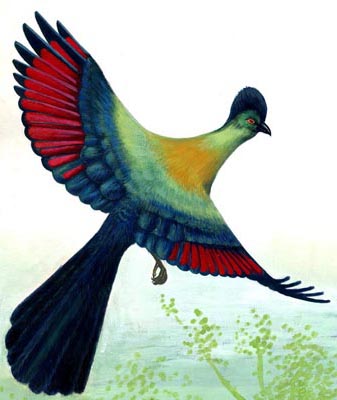


A provisional checklist for Mantenga's birds has been prepared, this includes species recorded from the eighth degree grid square which includes Mantenga, so is not accurate.
Black Collared Barbet
siSwati Name Sibagobe
Scientific Name Lybius torquatus
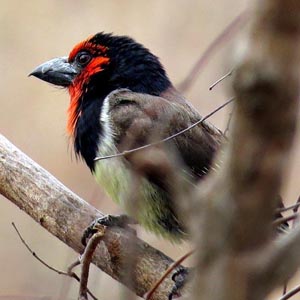
Identification Its has a red face and black upper breast and collar which extend to the top of its head, easily giving it away when perched or flying. The Black Collard Barbet is one of the bird species that have teeth like node on its beak.
Call These birds sway from side to side or bob up and down before they start a characteristic song that starts of with a slow "skrr-skrr" to a jolly "too-puddley-too-puddley." They call several times - one of the unforgettable calls of the African bush. Its siSwati name is taken from its call.
Habitat Black Collared Barbets are widely distributed in forest, near rivers and streams, woodlands and dry open forest.
Diet They feed on fruits and insects including termites and beetles.
Red-Chested Cuckoo
siSwati Name Phezukwemkhono
Scientific Name Cuculus solitarius
Red-Chested Cuckoos are summer visitors to Mantenga; its call announces its presence from late September, through it is seldom heard in winter.
Identification Chestnut color on its breast gives it its name and distinguishes it from the other cuckoos.
Call Males often call "weet-weet-weeoo" and females give a "pi- pi- pi" sound-the siSwati name for this bird derives from its call. Calls are made through out the day but mostly in the early mornings and dusk.
Habitat Red-Chested Cuckoos are a species of the forest, mature woodlands, exotic plantations and suburban gardens. Cuckoos perch motionless on the canopy tops of trees.
Diet They feed on caterpillars, beetles, some seeds and worms.
Cultural connection In Swaziland the Red-Chested Cuckoo is a popular bird, especially in rural areas. Alerts and lets people know its time wake up to go and plough their fields, hence the name.
Interesting facts Cuckoos are well known for being brood parasites, laying eggs in host species such as the Red-Capped Robin Chat, One egg is deposited per nest and when the egg hatches the chick evicts the other eggs or young.
Reed Cormorant
Scientific Name Phalacrocorax africanus
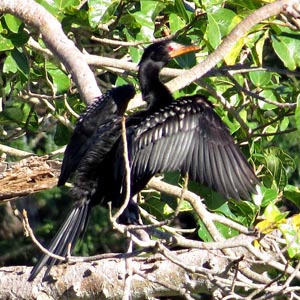
Identification Reed Cormorants are common water birds and can be easily mistaken for the African Darter. Cormorants have black body feathers, red eyes and a shorter neck and bill which is hooked at the end.
Habitat Reed Cormorants are inland residentsmainly found in dams and rivers. At Mantenga they can be found drying themselves on the rocks of the Lusushwana River.
Diet They feed on fish and frogs which they hunt under water and come up to the surface to swallow
Hadeda Ibis
siSwati Name Lingangane
Scientific Name Bostrychia hagedash
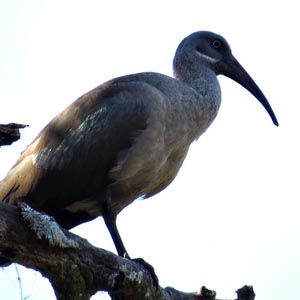
Identification Hadeda Ibis are noisy birds who have dull grayish brown bodies, but at close rage they have glossy bronze wings and back. They are large with a heavy build and short legs and the bill points downwards.
Call Hadedas get their name from their raucous call ("ha-ha-hadaha") which they make when startled, flying or early in the morning or dusk.
Habitat They occur in flocks on plantations, open bush, open veld and near streams.
Diet During breeding season, they can be seen in pairs foraging for mole crickets, green locust, beetles worms, snails and fly larvae in animal matter.
Cultural connection In siSwati children who mimic the call of the Hadeda Ibis are told that they would grow boils all over their bodies - story told to stop them from making noise!
Purple Crested Turaco
siSwati Name Ligwalagwala
Scientific Name Gallirex Porphyreolophus
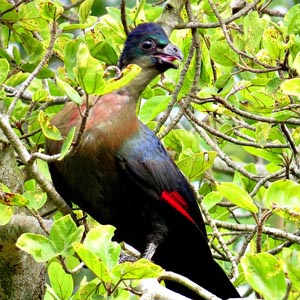
Identification The Purple Crested Turaco, commonly known as the Purple Crested Lourie. With its beautiful bright red wing feathers and black tips the Crested Turaco is one of the easy bird species to identify. The crest looks black but when the sun shines on the bird you can clearly see it is purple.
Call The call of the Touraco is unmistakable - a series of loud and explosive "Krooks" and "kok-kok-koks" . This is the only Turaco species found here at Mantenga Nature Reserve.
Habitat Purple Crested Turaco prefers broad leaf woodland and forest close to rivers.
Diet Their diet is mainly fruits such as wild figs, berries and wild plums.
Cultural connection Swazis have much respect for this bird, due to its royal connotations. Only royal family members can wear the feathers of this bird, which is the national bird of Swaziland.
Red-Capped Robin-Chat
Scientific Name Petroica goodenvoii

Identification The Red-Capped Robin-Chat is an elusive bird, more often heard than seen. But, it is unmistakable when seen due to its bright orange face, under belly and bluish grey wings and back. It is the only robin with an orange head and without eye markings.
Call Its call is a soft "see-saw-see-saw." When it calls there are usually others close who return its call and also mimic other birds.
Habitat This robin is a resident of dense forest, keeping to the undergrowth. Red-Capped Robin-Chat also prefers mature suburban gardens.
Diet They hunt for insects on the ground and only when certain fruits ripen will they move to the tree tops. These robins become active at dusk when they can be seen hopping around in the open.
Red Winged Starlings
siSwati Name Lisomi
Scientific Name Onychognathus morio
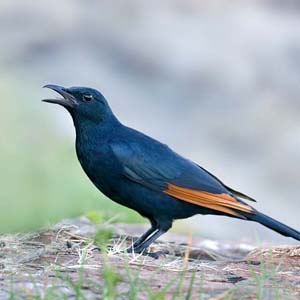
Identification Red Winged Starlings are quite easy to spot with large glossy black feathers, accented with brick red or chestnut wing feathers that are clearly visible in flight.
Call The Red Winged Starling gives a call of a clear whistled "cherleo" and a variety of melodious whistles; they fly in pairs or large groups and often perch on buildings, tree tops and even electricity poles.
Habitat Red Winged Starlings enjoy mountains, cliffs and hilly areas away from predators. These birds are have a permanent nest at the Mantenga Restaurant, and when breeding have been seen to be very aggressive - even to the point of chasing away monkeys!
Diet Red Winged Starlings eat fruit, insects, caterpillars, millipedes and can even prey on smaller birds.
Cultural connection This birdís whistle sounds like a man who is trying to get a lady's attention by whistling to her, so he can propose love to her.
Brown Hooded Kingfisher
siSwati Name Nonombe
Scientific Name Halcyon albiventris
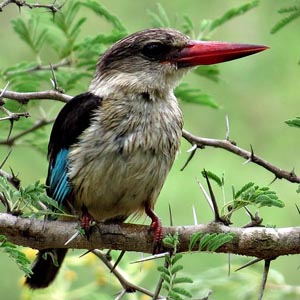
Identification The Brown Hooded Kingfisher has a brown head with black streaks, light brown patches on the side of its breast and streaked flanks, making it easy to differentiate from the Striped Kingfisher.
Call The Kingfisher is noisy bird, very often heard early in the morning making a noisy whistled "tyi-ti-ti-ti sound and when frightened a klee-klee-klee" note.
Habitat Brown Hooded Kingfishers live in non-aquatic, thornveld, broad-leaved woodland and coastal areas, thus making Mantenga a very suitable habitat for breeding and shelter.
Diet Food such as insects, beetles, grasshoppersand rarely crabs and fish.
Cultural connection Nonombe means sleepy or not feeling well, because of the way in which it looks like its sick or sleeping when sitting still on a perch.
Dark-Capped Bulbul
siSwati Name Ligibholo
Scientific Name Pycnonotus barbatus

Identification Dark-Capped bulbuls have a dark crested head and face and no color on its eye wattle. With a grayish brown back and whitish belly, the Dark-Capped Bulbul has, in contrast, bright lemon yellow under its tail. The most common cheerful and friendly birds.
Call They can be very noisy when predators such as snakes, cats and owls approach. Their call is a harsh and excited "gwit-gwit" or a "chit-chit."
Habitat The bulbul is fond of areas where there are a lot of trees and thick bushes, especially trees with a good source of food.
Diet They eat soft fruit, berries and insects which they catch from the air.
Southern Bald Ibis
siSwati Name Inkondlo
Scientific Name Geronticus calvus
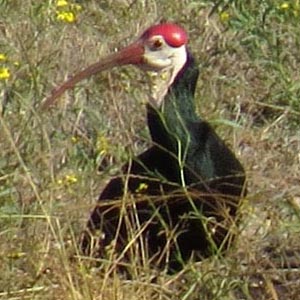
The Southern Bald Ibis is Mantenga's most treasured bird species; categorized as Vulnerable in "Threatened Vertebrates of Swaziland", the bird has been a permanent breeding resident at Mantegna for the past four years.
Identification The Southern Bald Ibis is an interesting looking bird, with a distinctive bald head, a whitish looking face and a de-curved red bill. Its body is a glossy black, with greenish-blue metallic colors and copper patches on the wings.
Habitat The Southern Bald Ibis prefers mountainous terrain and cliffs near rivers for breeding. There are only four areas in Swaziland that have been recorded to have breeding colonies and Mantenga is the newest.
Diet During non-breeding season Southern Bald Ibis are fond of foraging on burnt grasslands where they wander off to exploit natural grasslands and ploughed fields where they feed on insects, worms, caterpillars and carrion (dead animals).
Facts about the Southern Bald Ibis There are a number of factors that contribute to the decline in numbers of the Southern Bald Ibis in southern Africa. For example, mining activities, loss of habitat and traditional healers using birds for traditional medicines.
Our Contacts:
Head Quarters: (+268) 2416 1489/1179
Email: info@sntc.org.sz
King Sobhuza II Park: (+268) 2416 1489/1179
Email: ksmp@sntc.org.sz
National Museum: (+268) 2416 1489/1179
Email: curator@sntc.org.sz
Copyright © ESWATINI NATIONAL TRUST COMMISSION
Malolotja Nature Reserve: (+268) 2444 3241 / (+268) 2416 1480
Email: culturalvillage@sntc.org.sz
Mantenga Nature Reserve and Swati Cultural Village: 2416 1151/1178
Email: culturalvillage@sntc.org.sz
Mlawula Nature Reserve: (+268) 2383 8885 (Reception)
(+268) 2383 8453 (Senior Warden)
Email: culturalvillage@sntc.org.sz
Magadzavane Lodge: (+268) 2343 5108/9
Email: magadzavane@sntc.org.sz